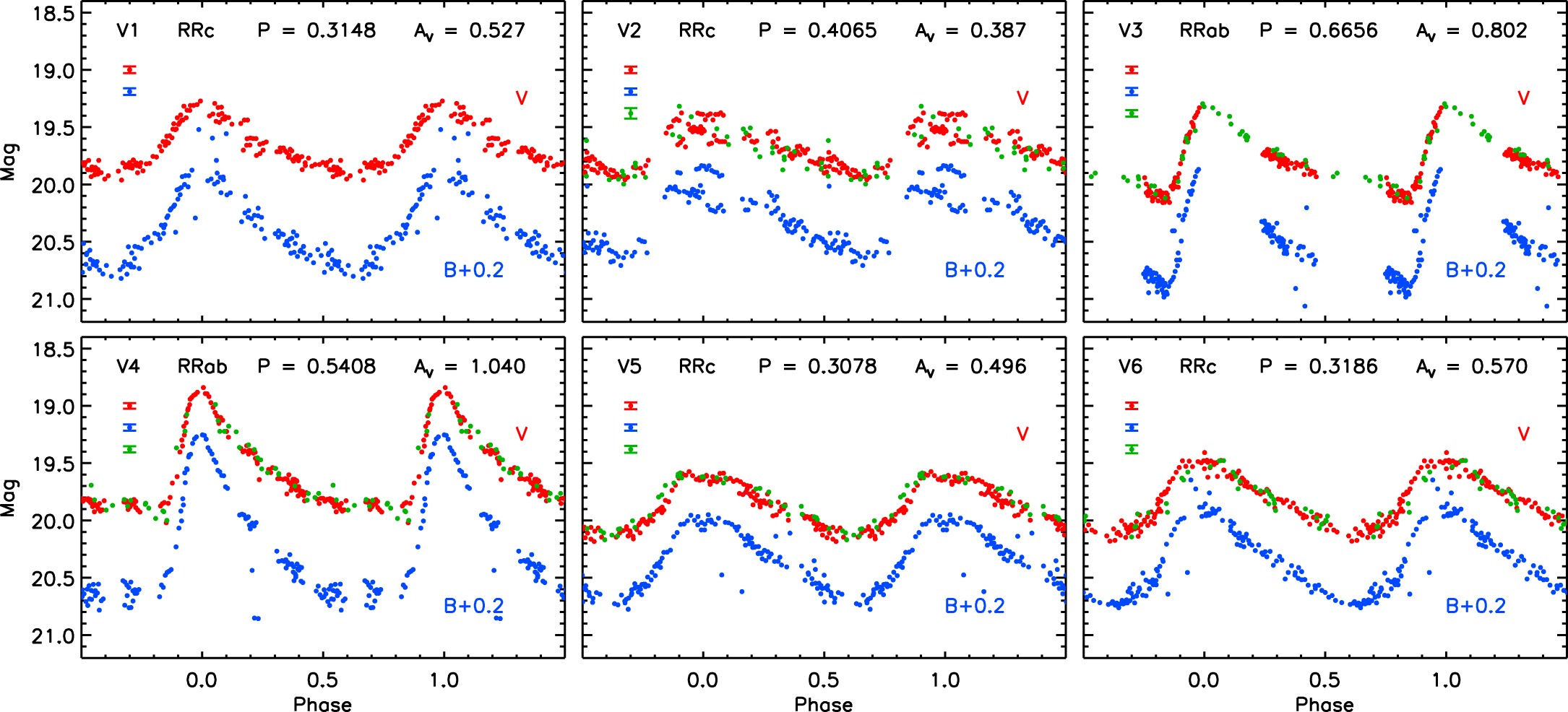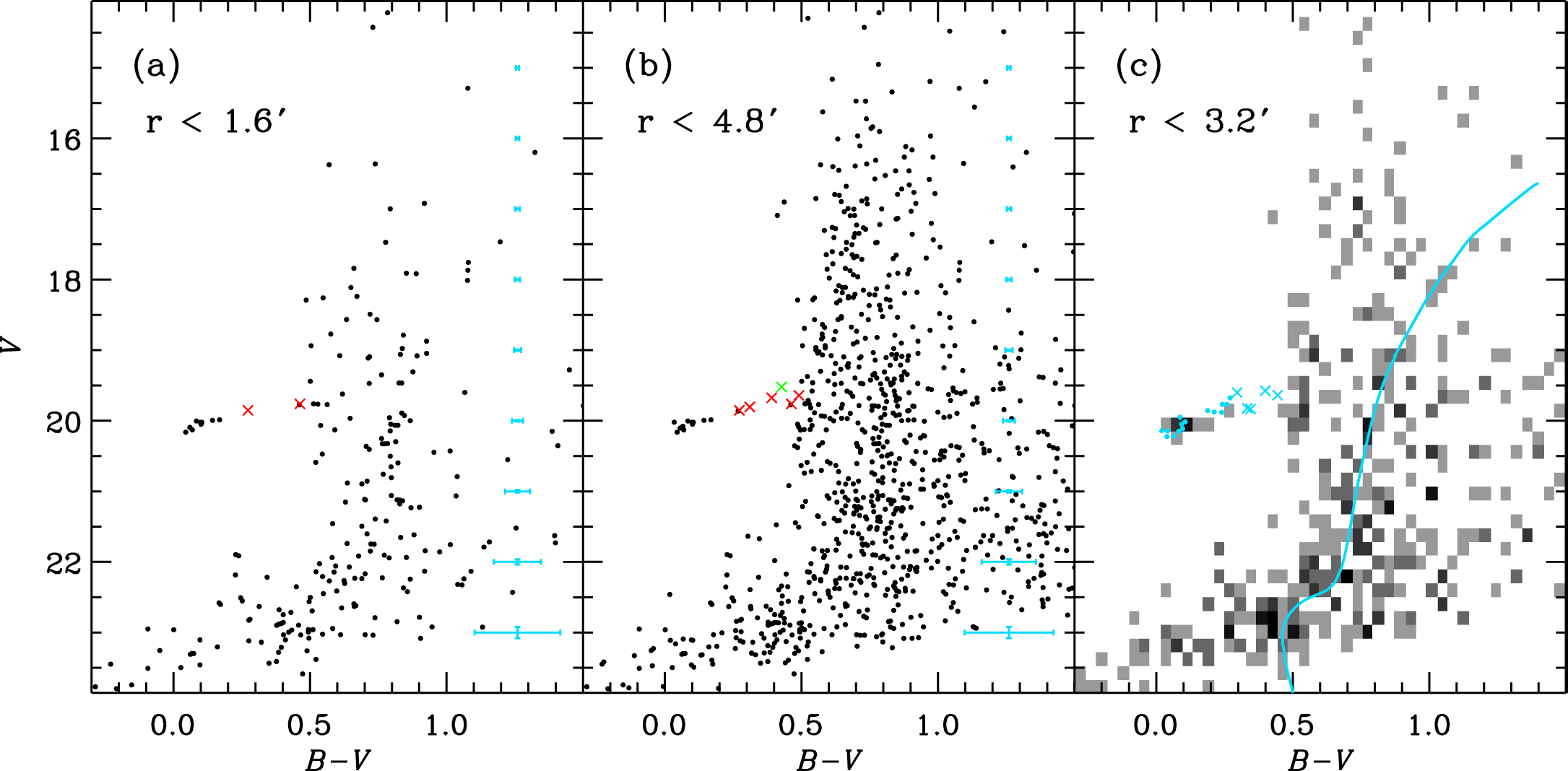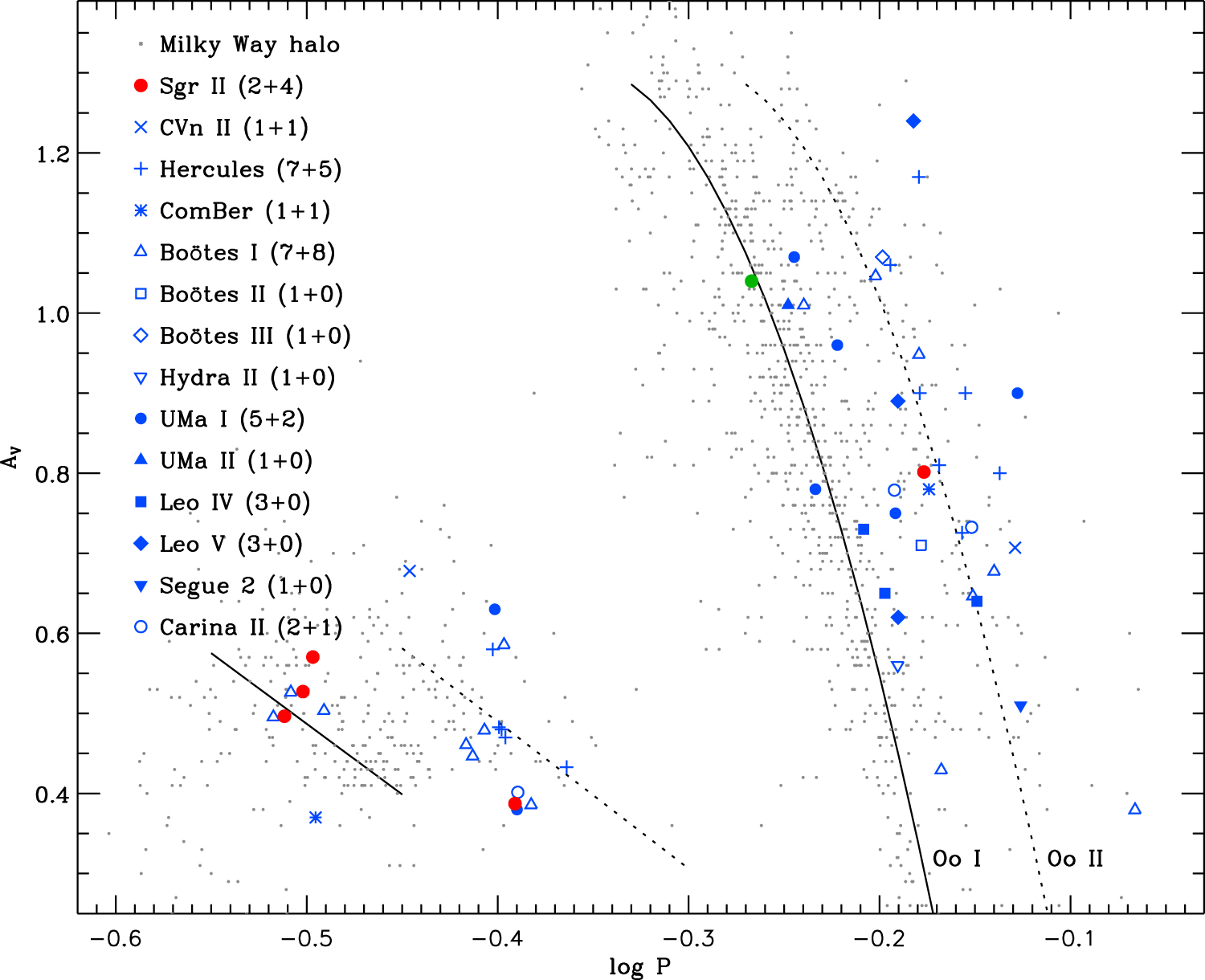RR Lyrae Stars in the Field of Sagittarius II
* The paper (Joo et al. 2019, ApJ, 875, 120) is summarized as following:
Recently discovered by Laevens et al. (2015) from the Pan- STARRS1 survey, Sgr II has a total luminosity of M_V ~ -5.2 and a heliocentric distance of ~67 kpc (see also Mutlu-Pakdil et al. 2018). Compared to typical UFDs(Ultra-Faint Dwarfs) with similar luminosities, it is relatively small and compact (half-light radius, rh ~ 32 pc or 1.6'), but is larger than usual globular clusters (GCs). In the size-luminosity plane, Sgr II can be classified as either the most compact UFD or one of the most extended GCs. We identify and analyze RR Lyrae variables by fitting light curve templates to our time-series photometry of Sgr II. We compare them with those stars of other UFDs in the period - amplitude diagram.
Time-series observations of the field of Sgr II were conducted in the B- and V-bands using the KMTNet-CTIO 1.6 m telescope on 17 nights from 2016 October to November and from 2017 September to October. In total, 117 and 121 frames were obtained for B- and V-bands, respectively, with an exposure time of 120 s. Point-spread function (PSF) photometry was performed using DAOPHOT II/ALLSTAR (Stetson 1987) and ALLFRAME (Stetson 1994) on the time-series data. We also used the time-series data from Gaia DR2 (Gaia Collaboration et al. 2018) for stars identified as variables in the field of Sgr II.
RR Lyrae variables in the field of Sgr II were detected and characterized using the template light-curve fitting technique outlined by Yang & Sarajedini (2012) and Yang et al. (2014). We selected variable candidates by examining the variability of stars at the level of the HB, and analyzed them by fitting template light curves. Readers are referred to Joo et al. (2018, Paper I) for details of the procedure we employed. Six RR Lyrae (two RRab and four RRc) stars were discovered in the Sgr II field. The light curves obtained with our best-fit templates are presented in Figure 1, where the green points are the Gaia G-band data converted to V-band. In Table 1, we summarize positions and pulsation properties of RR Lyrae stars including variable type, period, intensity-weighted mean magnitude, the number of observa- tions, and amplitude. We also list the information (ID, type, period, and the number of data points) from Gaia DR2 for the five variables matched with our data. We found that five out of the six variables are also identified as RR Lyrae stars in Gaia DR2 (Gaia Collaboration et al. 2018). For these five stars, V2 to V6, we included the Gaia time-series data in our light-curve analysis by transforming the Gaia G-band to V-band magnitudes based on the relations in Table A2 of Evans et al. (2018, see also Clementini et al. 2019). From the empirical period-amplitude-metallicity relation by Alcock et al. (2000), [Fe/H] = -2.1 +- 0.3 is obtained. We also estimate the distance to Sgr II using optical Period- Wesenheit (PW) relations provided by Marconi et al. (2015), which have the key advantage that they are reddening free and only marginally dependent on metallicity (see also Bono et al. 2019). In practice, we adopt metal-independent (V, B - V) PW relations (Marconi et al. 2015) for the four RR Lyrae stars (excluding V1 and V4), and obtain the mean distance modulus, (m - M)_0 = 19.03 +- 0.10 mag, and the mean heliocentric distance, de = 64 +- 3kpc, for Sgr II.


CMDs of the Sgr II field, for the region inside rh (~1.6'; Mutlu-Pakdil et al. 2018) and 3 rh (~4.8') are shown in Figure 2. To obtain the CMDs, we combined our time-series images and carried out PSF photometry with DAOPHOT II/ALLSTAR (Stetson 1987). Blue horizontal branch (HB) and red giant branch (RGB) stars of Sgr II are prominent over the background of field stars. To estimate the age of the stellar population in Sgr II, we have constructed population models using Yonsei-Yale (Y2) isochrones and HB evolutionary tracks (Yi et al. 2008; Han et al. 2009). With the fixed metallicity of [Fe/H] = -2.1 and alpha-element enhancement of [alpha/ Fe] = 0.3, the age value was adjusted until the model best matches the observed CMD. Our best-fit model with an age of 12 Gyr is presented.

Figure 3 shows the period?amplitude diagram of the RR Lyrae stars in the Sgr II field, and compares them with those in the MW halo and 13 UFDs with MV > -7, as an update of Figure 10 in Vivas et al. (2016) and Figure 6 in Paper I. It is clear from Figure 2 that RRab stars in the UFDs studied so far have mostly Oosterhoff-intermediate (Oo-int) or Oo II properties (see also Clementini 2010; Vivas et al. 2016), in contrast to those in the MW halo where the majority (73%) has Oo I properties (Zinn et al. 2014). We can then conclude that Sgr II is also similar to the other UFDs in the distribution of RRab stars on the period-amplitude diagram and is classified as Oo II. The blue HB morphology of Sgr II and the similarity in RR Lyrae properties between Sgr II and other UFDs suggest that Sgr II can be considered as a UFD, because outer halo GCs (>40 kpc) tend to have red HB morphologies (e.g., Lee et al. 1994; Laevens et al. 2015).

References
- Alcock, C., Allsman, R. A., Alves, D. R., et al. 2000, AJ, 119, 2194
- Cacciari, C., Corwin, T. M., & Carney, B. W. 2005, AJ, 129, 267
- Clementini, G. 2010, in Proc. Int. Variable Stars, the Galactic Halo and Galaxy Formation Conf., ed. N. Samus, C. Sterken, & L. Szabados (Moscow:Sternberg Astronomical Institute of Moscow Univ.), 107
- Clementini, G., Ripepi, V., Molinaro, R., et al. 2019, A&A, 622, A60
- Evans, D. W., Riello, M., De Angeli, F., et al. 2018, A&A, 616, A4
- Gaia Collaboration, Brown, A. G. A., Vallenari, A., et al. 2018, A&A, 616, A1
- Han, S.-I., Kim, Y.-C., Lee, Y.-W., et al. 2009, in Proc. ESO Astrophysics Symp., Globular Clusters: Guides to Galaxies, ed. T. Richtler & S. Larsen(Berlin: Springer), 33
- Holl B., Audard M., Nienartowicz K. et al 2018 A&A 618 A30
- Joo, S.-J., Kyeong, J., Yang, S.-C., et al. 2018, ApJ, 861, 23, (Paper I)
- Laevens, B. P. M., Martin, N. F., Bernard, E. J., et al. 2015, ApJ, 813, 44
- Lee, Y.-W., Demarque, P., & Zinn, R. 1994, ApJ, 423, 248
- Marconi, M., Coppola, G., Bono, G., et al. 2015, ApJ, 808, 50
- Mutlu-Pakdil, B., Sand, D. J., Carlin, J. L., et al. 2018, ApJ, 863, 25
- Stetson, P. B. 1987, PASP, 99, 191
- Stetson, P. B. 1994, PASP, 106, 250
- Vivas, A. K., Olsen, K., Blum, R., et al. 2016, AJ, 151, 118
- Yang, S.-C., & Sarajedini, A. 2012, MNRAS, 419, 1362
- Yang, S.-C., Wagner-Kaiser, R., Sarajedini, A., Kim, S. C., & Kyeong, J. 2014, ApJ, 784, 76
- Yi, S. K., Kim, Y.-C., Demarque, P., et al. 2008, in IAU Symp. 252, The Art of Modeling Stars in the 21st Century, ed. L. Deng & K.-L. Chan (Cambridge:Cambridge Univ. Press), 413
- Zinn, R., Horowitz, B., Vivas, A. K., et al. 2014, ApJ, 781, 22
- Zorotovic, M., Catelan, M., Smith, H. A., et al. 2010, AJ, 139, 357
Downloadable files: light curve text files and their plots.
* If you have questions, please contact Dr. Seok-Joo Joo ( sjjoo250@gmail.com)
* The use of the downloaded data from this website requires the following acknowledgment : "The data is acquired from the KASI (Korea Astronomy & Space Science Institute) archive."